Print Article
Author's Bias | Interpretation: conservative | Inclination: covenant | Seminary: Tyndale
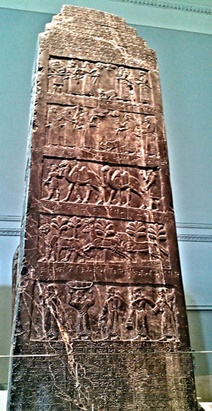
© Andres Rueda /
Wikimedia Commons
Sir Henry Layard discovered this black limestone obelisk in 1846 during his excavations at Kalhu, the ancient Assyrian capital.
The obelisk, now on display in the British Museum, celebrates the military achievements of Shalmaneser III (reigned 858–824 BC).
Made of black limestone, the four-sided Black Obelisk of Shalmaneser III is about 6-1/2 feet in height and its top is stepped
and shaped like a ziggurat. Each side has five vertically carved relief scenes depicting a vassal king paying tribute / homage to
the Assyrian king Shalmaneser III.
Viewing each carved relief and its Akkadian cuneiform in a counter clockwise direction around the obelisk, each
scene tells a story about a different vassal king. Listing the kings from the top, scholars have determined who Shalmaneser conquered
over 31 years of military campaigns:
1. Sua of Gilzanu (Northwest Iran): "I received tribute from Sua the Gilzanean: silver, gold, tin, bronze
casseroles, the staffs of the king's hand, horses and two-humped camels."
2. Jehu of Bit Omri (Jehu of the House of Omri – Northern Kingdom of Israel): "I received tribute from Iaua, son
of Omri: silver, gold, a gold bowl, a gold tureen, golden vessels, gold pails, tin, a staff of the king's hand, and wooden
spears."
3. An unnamed ruler of Musri (Egypt?): "I received tribute from Muṣri: two-humped camels, a water buffalo, a
rhinoceros, an antelope, female elephants, female monkeys and apes."
4. Marduk-apil-usur of Suhi (middle Euphrates): "I received tribute from Marduk-apla-uṣur, the Suhean: silver,
gold, pails, ivory, spears, byssus, garments with multi-colored trim and linen garments."
5. Qalparunda of Patin (Antakya region of Turkey): "I received tribute from Qarparunda the Patinean: silver, gold,
tin, bronze compound, bronze utensils, ivory and ebony." (1)
While there are other Assyrian and Babylonian texts that mention Hebrew kings, this obelisk depicts the earliest surviving picture
of an Israelite king. The panels depict the Israelite King Jehu bringing tribute to King Shalmaneser III in around 841 BC. However,
while the Black Obelisk states that Jehu is the son of Omri, 2 Kings 9:2, 14 states
that Jehu is the son of Jehoshaphat, the
son of Nimshi. How does one reconcile this apparent contradiction? There are three possible proposed solutions.
1. One of the two accounts is inaccurate. Either the Black Obelisk is inaccurate as our modern newspapers are
often in error (2) or biblical critics would say the Bible is inaccurate.
2. Kyle McCarter challenges the reading of the Black Obelisk that it is not Jehu but is actually referring to
Jehoram (Joram), the grandson of King Omri whom Jehu killed. (3) However, Gallil dismisses this interpretation
on linguistic grounds. (4)
3. Tammi Schneider argues that Jehu may have been a descendant of Omri. (5)
4. K. Lawson Younger has pointed out that it was the custom of the Assyrians to denote countries "by the name
of the founder of the ruling dynasty at the time of their first acquaintance with it." (6) He gives a couple
of other examples that support this claim. If this is true, Shalmaneser wasn't trying to make the (mistaken) claim that Jehu was
of the same blood line or dynasty as Omri, but simply identifying him in the way they were accustomed to doing. This seems to
explain the statement without having to resort to changing the text of the Black Obelisk (McCarter) or of the Bible (Schneider).
However, even if the mystery is not resolved, the presence of both Omri and Jehu mentioned in an extrabiblical
text lends credibility to the notion that they were real historical individuals.
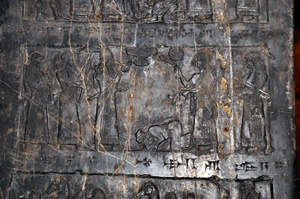
Accompanied by four attendants, King Shalmaneser III
stands beneath a parasol with Jehu bowing before him.
© Helpmewithbiblestudy.org
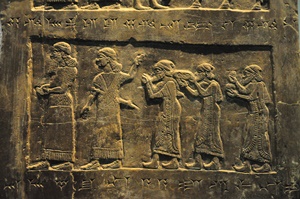
Accompanied by two Assyrian officials, three Israeli
tribute-bearers carry "silver, gold, gold vessels, tin."
© Helpmewithbiblestudy.org
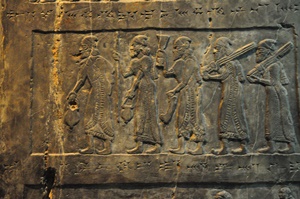
Five Israeli tribute-bearers carry a gold bowl, a golden tureen,
gold vessels, gold pails, tin, the "staffs of the king's hand" / spears.
© Helpmewithbiblestudy.org
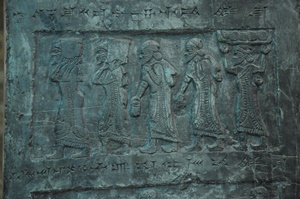
Five Israeli tribute-bearers carrying silver, gold, a
gold bowl, a gold tureen, gold vessels, gold pails / tin.
© Helpmewithbiblestudy.org
Dr. David E. Graves (Ph.D., University of Aberdeen, Scotland) has been involved in teaching the
Bible and archaeology for more than thirty-five years and is currently an Assistant Professor with Liberty University, Rawlings
School of Divinity. He has taught archaeology at Oxford University, England; provided tours of the Ashmolean and British Museums;
traveled extensively in the Middle East; and been involved in Mount Ararat research. He is currently a supervisor at the Shiloh
excavations, Israel and was part of the team who discovered and excavated the Dead Sea Scroll cave Q12 near Qumran, Israel (Jan 2017)
and Tall el-Hammam (Sodom?), Jordan (2005-2015); and is a member of the Near East Archaeological Society (NEAS). To learn more
about biblical archeaology, visit:
Biblicalarchaeologygraves.blogspot.com.
An obelisk monolith is a stone pillar that is made of a single stone. Set in the courtyard outside of a
large and centrally located building in the ancient city of Kalhu, the Black Obelisk of Shalmaneser III served
as a monument and reminder of the Shalmaneser III's power and authority.
Footnotes:
1. James Bennett Pritchard, ed., The Ancient Near East, Volume 1: An Anthology of Texts and Pictures (Princeton, N.J.: Princeton University Press, 1973), 192.
2. Hal Flemings, Examining Criticisms of the Bible (Bloomington, IN: AuthorHouse, 2008), 109.
3. P. Kyle McCarter, "'Yaw, Son of ‘Omri': A Philological Note on Israelite Chronology," Bulletin of the American Schools of Oriental Research, no. 216 (December 1974): 5–7.
4. Gershon Galil, The Chronology of the Kings of Israel and Judah (Leiden: Brill, 1996), 33 n. 2.
5. Tammi Schneider, "Did King Jehu Kill His Own Family?," Biblical Archaeology Review 21, no. 1 (1995): 26–33, 80–82.
6. Younger, Context of Scripture, vol 2, p. 267, n.5.
"
Copyright ©
2018
Helpmewithbiblestudy.org. All rights to this material are reserved. We encourage you to print the material for personal and
non-profit use or link to this site. If you find this article to be a blessing, please share the link so that it may rise in
search engine rankings.